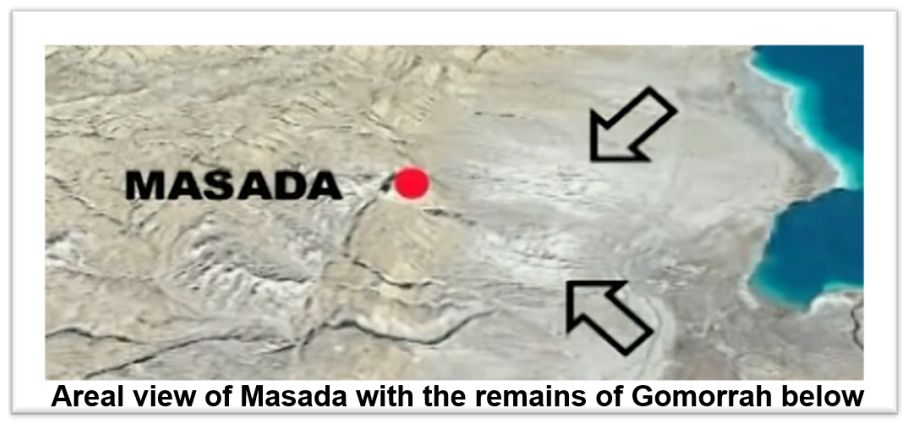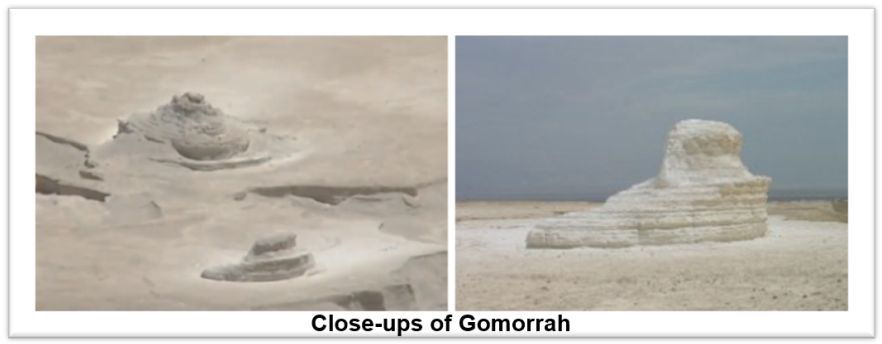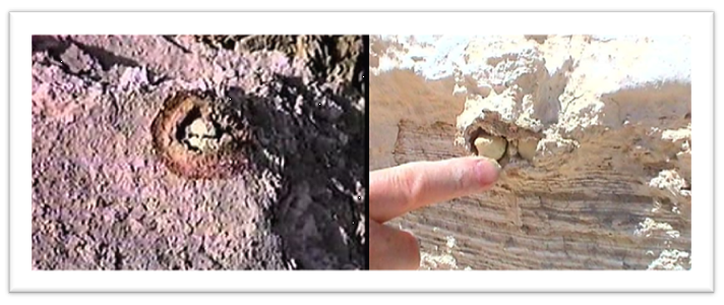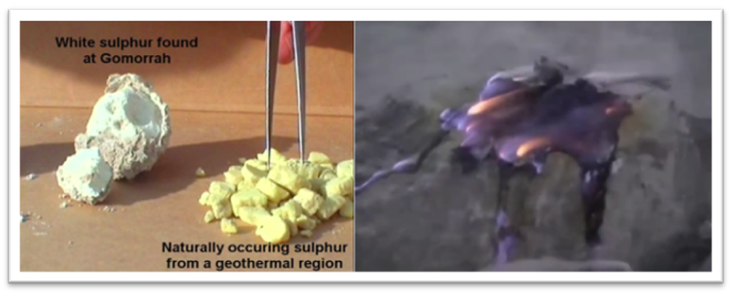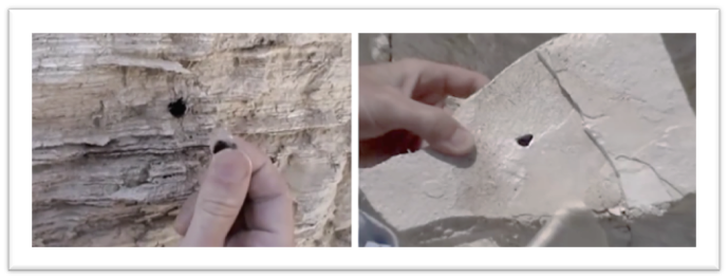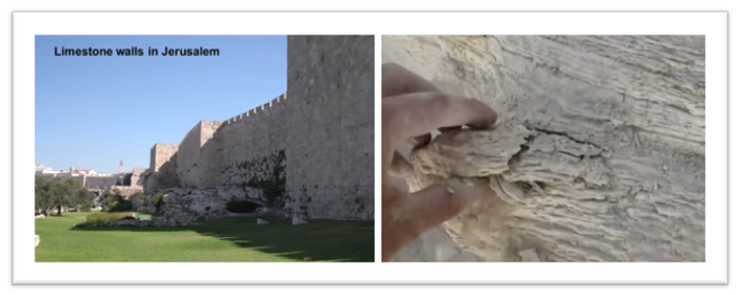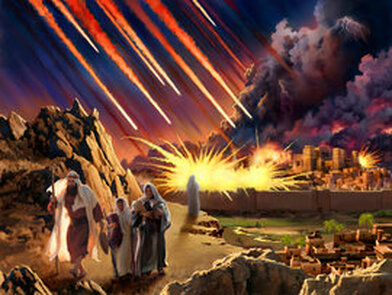
by George Sidney Hurd
To the average Christian this topic may seem irrelevant since they accept the biblical account of Sodom and Gomorrah as recorded for us in the Scriptures. However, we are living in a time in which most long-held beliefs are being deconstructed and reinterpreted in a manner less confrontational and offensive to the sensibilities of our postmodern permissive society. The God of the Scriptures is being repackaged so as to affirm and even approve of modern man’s sinful lifestyles rather than confronting and judging them. The Evidence of Sodom’s Destruction The Liberal Modernists of the past typically rejected the Bible outright, even denying that the cities of Sodom and Gomorrah ever existed. However, sooner or later archeological discoveries usually uncover evidences which substantiate the biblical account, and the existence of Sodom and Gomorrah is no exception. In 1964 a team of archaeologists discovered the remains of an ancient city in northern Syria which was later identified as Elba, the seat of an ancient empire contemporary with the Patriarchs. In the excavation they discovered more than 2,000 tablets written in cuneiform text. The tablets contain the names of many of the ancient cities mentioned in Genesis, including all five of the cities of the plain which are recorded as having been destroyed in Genesis, and they were referred to in a tablet as “sin cities.” 1 These tablets date as far back as 2,300 B.C., some 450 years before Sodom and the cities of the plain were destroyed according to Genesis 19. Today, most Postmodern Progressive scholars do not outright reject the Scriptures as did the Modernist Liberals. Instead they reinterpret and nuance the obvious meaning of the text so as to accommodate our present society’s moral standards and sensibilities. Some, without outright rejecting the biblical account, argue that the destruction of Sodom and Gomorrah was not a real historical event, but merely a story invented by men in order to control the people through fear. However, once again, the archeological evidence is not on their side. To me there is ample evidence to convince any unbiased individual that the ashen remains of each of the five cities still remain to this day. The Genesis account says that Sodom and the cities of the plain were totally destroyed by fire and sulfur rained down from heaven: “Then the Lord rained brimstone and fire on Sodom and Gomorrah, from the Lord out of the heavens. So He overthrew those cities, all the plain, all the inhabitants of the cities, and what grew on the ground.” (Gen 19:24-25). Both Peter and Jude make reference to the destruction of Sodom and Gomorrah as being an observable sign in their day for all to see. Peter said of their destruction: “and turning the cities of Sodom and Gomorrah into ashes, condemned them to destruction, making them an example (hupodeigma) to those who afterward would live ungodly.” (2 Peter 2:6) Here Peter says that God made an example or “visible display” (hupodeigma) of Sodom and Gomorrah for future generations to see, so that they would not follow after the same immoral practices. The visible display is said to be the ashen remains of the cities. In like manner, Jude says: “as Sodom and Gomorrah, and the cities around them in a similar manner to these, having given themselves over to sexual immorality and gone after strange flesh, are set forth as an example (deigma), suffering the vengeance (dike ‘justice’) of eternal fire (pur aionios, 'eonian fire’).” (Jude 7) Here Jude uses a form of the same Greek term as Peter, (deigma), which Vine’s Expository Dictionary defines as, “specimen, thing shown.” The emphasis of both Peter and Jude taken together is that Sodom and Gomorrah were an observable sign in the form of ashen remains, demonstrating that God will judge those who continue in the same sexually immoral practices as those of the Sodomites. Peter and Jude are not the only ones of that time who spoke of the ashen remains of the cities of the plain which God had destroyed. The Jewish historian Josephus who was a contemporary of Peter and Jude said of their destruction: “The country of Sodom borders upon it (Dead Sea). It was of old a most happy land, both for the fruits it bore and the riches of its cities, although it be now all burnt up. It is related how, for the impiety of its inhabitants, it was burnt by lightning; in consequence of which there are still the remainders of that Divine fire, and the traces [or shadows] of the five cities are still to be seen… And thus what is related of this land of Sodom hath these marks of credibility which our very sight affords us.” 2 Josephus, nearly 2,000 years after Sodom’s destruction, said that the formations or shadows of all five of the cities could still be seen. They were not buried in tells and partially preserved as some of the smaller communities on the eastern side of the Dead Sea were. Other cities were rebuilt on top of the ruins of those cities, but according to the Scriptures the cities of Sodom were reduced to ashes, never to be rebuilt, and they still remained visible on the surface as an example to those who afterward would live ungodly (Zeph 2:9; Isa 13:19-20; Jer 49:18). Also, Strabo, the Greek geographer, philosopher and historian who lived from 63 B.C. to 23 A.D. says, “There were once inhabited cities in that region of the Dead Sea near Masada under the metropolis city of Sodom.” 3 The remains of Herod’s fortress Masada overlook the ashen remains of Gomorrah, one of the cities of the greater Sodomite metropolis. They can be clearly seen from that vantage point as we see in the following images:
Today, nearly 2,000 years after Josephus, its ashen remains still can be seen as a visible testimony to the judgment of God against persistent unbridled immorality. The closer one examines the remains, the more evident it becomes that they are indeed a solemn testimony to God’s judgment upon the cities of Sodom. The ashen remains are not found in the rest of the plain, but are confined to the sites of the five cities as indicated in the following images:
Other tells, such as Tall el-Hammam in the northeastern end of the Dead Sea, show signs of having been destroyed by fire as well, but they were not reduced to ashes as the biblical account says concerning the five cities of the plain which were utterly destroyed. Strabo indicates that there were other cities in the valley apart from those of the Sodomite metropolis. He said: "there were once thirteen inhabited cities in that region of which Sodom was the metropolis” 4
Upon closer examination of the ashen remains of the cities it becomes even more evident that they correspond with the Genesis account of their destruction. Genesis 19:24 says that the Lord “rained brimstone and fire” upon the cities. Brimstone is the old English word for sulfur. Imbedded within the layers of ash are an abundance of sulfur balls of varying sizes with a crystalized shell which formed when the burning balls of sulfur were extinguished in the ash before being fully consumed. This is the only place in the world where sulfur has been found in this form.
The sulfur from the sites is unique from any sulfur found in other parts of the world. The sulfur produced by geothermal activity is only around 40 percent pure, whereas numerous laboratory tests have found the white sulfur from the cities of the plain to be from 94 to 98 percent pure sulfur with trace amounts of magnesium which combined produce sufficient heat to melt even stainless steel. Additionally, naturally formed sulfur does not appear in balls as those found in these sites.
Also, occasionally charcoal or partially burned wood is found trapped in the layers of ash, having been deprived of oxygen before they could be fully consumed.
The ashen remains of these cities are pure calcium sulfate which is the byproduct of intense heat and sulfur consuming limestone which is composed of calcium carbonate. Most of the structures of that region were made of cut limestone. The ash formed in thin layers which easily crumble into powder.
In some areas the layers appear in swirling formations which would be the result of a firestorm or thermal ionization caused by electrons repelling and attracting under extreme heat as seen in the following images.
This divine fire is reminiscent of the fire of the Lord which fell upon the alter after Elijah had prayed, consuming not only the sacrifice, but also the wood and the very stones of the alter itself (1Kings 18:38). Aside from the fact that the Scriptures say that it was the Lord Himself who rained down brimstone and fire upon Sodom from heaven, the very details of the forensic evidence taken together indicate that these cities were destroyed by means not natural to this planet.
While those who do not wish to retain the knowledge of God will always seek to discredit the evidence, in my opinion, as Peter and Jude said, the destruction of Sodom and Gomorrah is a visible example to all subsequent generations, demonstrating that God will judge those who do not judge themselves (2 Peter 2:6; Jude 7; Heb 13:4). I believe that the evidence is so compelling as to leave man without excuse in the day of judgment. For a more detailed description, watch: Sodom & Gomorrah - true location found - Ross Patterson; Sodom and Gomorrah and The Search for Sodom and Gomorrah;. Who Destroyed Sodom? Some, while reluctantly conceding that cataclysmic events such as the flood and the destruction of Sodom and Gomorrah actually took place, nevertheless attempt to argue that it wasn’t God Himself who destroyed the cities. This in spite of the specific terms attributing the destruction to God Himself. God said to Abraham that He would not destroy Sodom if He found even ten righteous within the city (Gen 18:32). God clearly takes responsibility for Sodom’s destruction. Progressives like Gregory Boyd argue that God is exclusively non-violent cruciform love, and therefore He would have never destroyed Sodom (I consider his arguments in my book “The Ways of God” As seen through the eyes of a Conservative Restorationist). Boyd argues that God simply “withdrew his protective hand to allow anti-creational forces that are ‘bent on destruction’” to carry out the judgment on the cities. 5 However, when the two angels told Lot that the cities were going to be destroyed, they said to him: “For we will destroy this place…the Lord has sent us to destroy it.” (Gen 19:13). Could we reasonably say that God’s angels are anti-creational forces that are bent on destruction? The language of Scripture does not allow us to separate God from Sodom’s destruction, as Boyd attempts to do. Genesis 19:24 emphatically says, “Then the Lord rained brimstone and fire on Sodom and Gomorrah, from the Lord out of the heavens.” In light of this, how can we reasonably attribute Sodom’s destruction to malevolent destructive forces? Some would argue that the human author of Genesis mistakenly presented God as being the one who destroyed the cities – that Moses simply interpreted the destruction event according to his own distorted perception of God. They would say that, in order to know how God truly is, we must learn from Jesus. However, Jesus consistently authenticates the entirety of the writings of Moses and the Prophets as inspired of God and infallible (Matt 4:4; Jn 10:35; Mark 14:49; Matt 5:18; 26:56; Luke 21:22; 24:44; John 13:18; 15:25, etc.). Additionally, in Luke 17 Jesus not only affirms the historicity of God’s judgment upon Sodom, but also warns that the circumstances surrounding His return will be similar: “Likewise as it was also in the days of Lot: They ate, they drank, they bought, they sold, they planted, they built; 29 but on the day that Lot went out of Sodom it rained fire and brimstone from heaven and destroyed them all. 30 Even so will it be in the day when the Son of Man is revealed.” (Luke 17:28-30 cf. Rev 6:15-17). There is no indication that Jesus understood the destruction of Sodom to have been executed by malevolent forces rather than by God Himself. In fact, the New Testament uses similar language to describe the judgment that the Son of Man will Himself bring against the Antichrist and his followers when He is revealed from heaven: “when the Lord Jesus is revealed from heaven with His mighty angels, 8 in flaming fire taking vengeance (ekdikesis “executing justice”) on those who do not know God, and on those who do not obey the gospel of our Lord Jesus Christ. 9 These shall be punished with (tino, “shall pay the penalty of”) everlasting (aionios “eonian”) destruction from the presence of the Lord and from the glory of His power.” (2 Thess 1:7-9) The God of the Old Testament is the same Lord Jesus Christ who comes in flaming fire, executing justice upon the ungodly at His Second Coming (cf. Rev 19:11-15). It is true that the just penalty is measured according to each man’s works and it will be eonian destruction, rather than an eternal destroying. Indeed, even Sodom will ultimately be restored (Ezek 16:53-55 ESV 6 ). But that doesn’t change the fact that it is God Himself who judges His people. As the writer of Hebrews says: “For we know Him who said, "Vengeance is Mine, I will repay," says the Lord. And again, "The Lord will judge His people." 31 It is a fearful thing to fall into the hands of the living God.” (Heb 10:30-31) While it is true that, in the coming ages, in the times of the restoration of all – the dispensation of the fullness of the times, all will have finally been restored, being reunited in Christ (Acts 3:21; Eph 1:10), the consequences of persisting in unrepentant sin are nevertheless very serious and age during. While the inhabitants of the cities of Sodom will eventually be restored, at least some of them have been in a conscious state in hades for more than 4,000 years awaiting their sentence on the day of judgment (Matt 10:15). While it is the subject of another blog, hades, or seol in the Hebrew text is the invisible abode of the souls of the dead and not the grave where our bodies are laid to rest, as is claimed by some teachers such as Don Keathley. 7 For those who are interested, I demonstrate from the Scriptures that our souls continue in a conscious state after death in my blog: "Is Sheol the Grave?" and in my book “Extermination or Restoration? (A Restorationist’s response to Annihilationism)” Contrary to modern popular opinion, affirming someone living in sin, rather than confronting them and warning them concerning God’s judgment upon the unrepentant, is not love. It is either unbelief concerning the warnings of God’s judgment given to us in Scripture – often by Jesus Himself, or else it is a lack of love and concern for the wellbeing of the unrepentant sinner. If we truly love someone and believe that God’s Word is true, we will not affirm them in their sinful lifestyle. We will warn them and earnestly intercede for them until they come to themselves and repent before God. Affirming sinful behavior, rather than confronting it, is what characterizes all the false prophets. They are those who cry “peace and safety” instead of warning of impending judgment (1Thess 5:1-3; Ezek 13:16; Jer 14:14-16). This is what the false prophets did in the Old Testament whenever God warned through His prophets that judgments were impending. And Jesus warned that there would be many such false prophets just prior to His return: “Then many false prophets will rise up and deceive many. 12 And because lawlessness will abound, the love of many will grow cold. 13 But he who endures to the end shall be saved.” (Matt 24:11-13) Many false teachers have recently arisen within the Church who “deconstruct” the Scriptures and its revelation of God’s nature and His ways so as to remove all fear of God. They rightly say that perfect love casts out all fear (1Jn 4:18). However, it is also true that the fear of the Lord is the beginning of wisdom (Ps 111:10). Any child who loves and respects his father knows that fear and love are not incompatible. If we are privileged to have had a good father who loved us, we know the love/fear relationship to one in authority. As long as we were obedient, the only emotion we felt was a positive one of love and respect (reverential fear). However, when we stepped beyond his established boundaries, even though we knew that he loved us and for that very reason corrected us, our predominant emotion was a negative one of fear because we knew he would discipline us. In fact, as the writer of Hebrews says, God disciplines and scourges us precisely because of His love for us (Heb 12:5-7). A parent who does not set standards and enforce them is a negligent parent, not a loving one (Pro 13:24). We are living in an increasingly hedonistic society that despises all authority and says, “if it feels good, do it.” And many who do not outright deny God’s existence, instead of repenting of their sins and submitting to God, seek out for themselves teachers who reconstruct God, presenting Him as though He were an all consenting father who is totally okay with whatever one happens to be into (2Tim 4:1-4). The result is that “there is no fear of God before their eyes." (Rom 3:18). Jesus said that in the time of His return it will be as it was in the days of Lot. When the angels came into Lot’s house all the men of the city gathered at the door and insisted that Lot send them out to them so that they could gang-rape them. When Lot reproached them for what they were doing, they condemned him for judging them (Gen 19:9). Even when they were supernaturally blinded by the angels, they did not fear God and repent, but continued groping for the door until they wore themselves out (Gen 19:4-11). Clearly, God Himself takes responsibility for the destruction of Sodom. And Jesus, as well as Peter and Jude, warn that if we obstinately follow in their footsteps, God who is no respecter of persons will likewise judge us. Many who have been conditioned to see God as being an all-permissive father will no doubt protest against this. But Paul would respond saying: “Is God unjust who inflicts wrath? (I speak as a man.) Certainly not! For then how will God judge the world?” (Rom 3:5-6). God will judge the world, even as He judged Sodom and Gomorrah. Don’t believe the false prophets when they cry peace and safety, contrary to the warnings of Jesus and all the Scriptures (1Thess 5:3). Why was Sodom Destroyed? Historically, it has been held by both Jews and Christians alike that, although Sodom was guilty of many sins, they were destroyed primarily because of their practice of homosexuality. This conclusion is largely based upon Genesis 19:4-5 where it says: “But before they lay down, the men of the city, even the men of Sodom, compassed the house round, both old and young, all the people from every quarter: 5 And they called unto Lot, and said unto him, Where are the men which came in to thee this night? bring them out unto us, that we may know them.” (Gen 19:4-5 KJV) Among the Hebrews, to say that someone “knows” another in such contexts was a discreet way of referring to sexual intercourse (Gen 4:1,17,25; 24:16; 38:26; Matt 1:25, etc.). Recently, some have sought to argue that the demand made by the men of Sodom was not to know them sexually but interrelationally. They point out that “know” is most commonly used in the Scriptures in a nonsexual manner. From this they argue that they were merely demanding that they be allowed to interview them. However, in the context it is clear that “know” is used in a sexual sense. When they insisted upon knowing them Lot offered to send out to them his own virgin daughters who had never “known” a man (Gen 19:8). It is obvious that he wasn’t merely offering to let them converse with his daughters. In Judges 19 there is a similar incident where an elderly man invited a man with his concubine to stay in his house for the night rather than spending the night in the open square. What took place afterwards is difficult to read but illustrates what is meant by the men wanting to “know” someone in this sense: “As they were enjoying themselves, suddenly certain men of the city, perverted men, surrounded the house and beat on the door. They spoke to the master of the house, the old man, saying, "Bring out the man who came to your house, that we may know him carnally!" 23 But the man, the master of the house, went out to them and said to them, "No, my brethren! I beg you, do not act so wickedly! Seeing this man has come into my house, do not commit this outrage. 24 Look, here is my virgin daughter and the man's concubine; let me bring them out now. Humble them, and do with them as you please; but to this man do not do such a vile thing!" 25 But the men would not heed him. So the man took his concubine and brought her out to them. And they knew her and abused her all night until morning; and when the day began to break, they let her go.” (Judg 19:22-25) This parallel incident demonstrates beyond doubt that the demand to be allowed to “know” someone in these contexts is in order to have sexual relations with them and not merely to be able to question them. Clearly, in the context of Genesis 19, the sin that finally resulted in Sodom’s destruction was homosexual activity or sodomy. That is why Jude, the half-brother of Jesus, names the sin of Sodom as that of having given themselves over to sexual immorality and gone after strange flesh (Jude 7). In a similar manner Paul speaks of the homosexual relations of women with women or men with men as shameful vile passions against nature (Rom 1:24-28). Some argue that the sin of Sodom was inhospitality rather than the sin of homosexuality. They cite Ezekiel 16 which says: “Look, this was the iniquity of your sister Sodom: She and her daughter had pride, fullness of food, and abundance of idleness; neither did she strengthen the hand of the poor and needy. 50 And they were haughty and committed abomination before Me; therefore I took them away as I saw fit.” (Ezek 16:49,50) Here, as in Romans chapter one, we see a downward spiral. In this case we see that it began with pride and excess and spiraled into laziness, indifference and finally committing the abomination. Committing the abomination was what provoked the severe judgment of the Lord – not a lack of hospitality (“they…committed the abomination...therefore I…” What is the abomination they committed? Certainly, it was not inhospitality. In the first place, inhospitality is a sin of omission - not commission. What sin is Sodom historically known to have committed that could be aptly described as an abomination? Homosexuality. That is why sodomy has historically been utilized as a synonym for the homosexual lifestyle. Lack of hospitality is never referred to in Scripture as an “abomination” requiring the death penalty. God would have been acting outside of His own law if He were to inflict the death penalty upon them for failing to show hospitality. The law of God did not prescribe the death penalty for failing to give to the poor, but it did require the death penalty for the abomination of homosexual activity: “If a man lies with a male as he lies with a woman, both of them have committed an abomination. They shall surely be put to death.” (Lev 20:13 cf. 18:22) What abomination did Sodom commit that justified their death penalty as an example? This phrase “committed an abomination” as it appears here in singular form (Heb. tow`ebah) is the same as “committed abomination” in Ezekiel 16:50. In Scripture the expression “commit abomination” in the singular refers to the homosexual act. For this reason, Jude attributes their destruction to sexual immorality with strange flesh (Jude 7). “Strange flesh” (sarcos heteras) refers to any body of flesh except for that for which the man was designed to have sex. The male penis was designed for the woman’s vagina, but the anus is designed for elimination – not penetration. Paul, in similar manner, referred to same-sex relations as “vile” and “that which is against nature.” (Rom 1:26). Apart from it being contrary to God’s design and an affront to Him, such practices against nature cause many severe health issues in addition to AIDS. It is common to hear the proponents of homosexuality say, “Jesus didn’t say anything about homosexuality, so it must be okay.” However, there would have been no need for Him to address the issue since it was already understood in Judaism to be a grave sin. There was no incident of homosexuality presented to Him requiring His comments, as was the case with adultery. He didn’t address incest, pedophilia or bestiality either because they likewise were non-issues among the Jews of His time. Also, these sins, along with homosexuality, were explicitly forbidden in the Law, and Jesus upheld the Law. No doubt, if someone were to have questioned Him concerning homosexuality, He would have referred them to the Law, just as He did on more than one occasion (Matt 19:4; Luke 18:20). We must keep in mind that Jesus is God and therefore the divine Author of both the Old and New Testaments. Also, implicit in His description of Sodom’s destruction and their judgment when He returns is His condemnation of unrepentant homosexual activity (Luke 17:28-30; Matt 10:15). Since I, as with most people in our times, have close relationships with people I love who are practicing homosexuals, I have sought to understand the issue from every different angle, reading books both for and against the homosexual lifestyle. Perhaps the most carefully thought out attempt to reconcile Christianity to the Gay lifestyle that I read was “God and the Gay Christian” by a young man named Matthew Vines. He acknowledges that the men of Sodom attempted to forcefully engage in anal sex with the two angels, thinking that they were men. However, he and other Gay advocates within the Church, argue that, that which God disapproves of is not the same sex act in and of itself, but rather promiscuous sexual activity with multiple mates outside of a loving committed relationship between two individuals. 8 However, the prohibition in Leviticus 18 and 20 is not merely that of promiscuous sex. It is against any man laying with a male as he lies with a woman (Lev 18:22). Likewise, what Paul refers to as being against nature is simply referred to as women with women and men with men (Rom 1:26-27). To say that Paul was only referring to sexual promiscuity is reading into the text that which is not stated. Some point out that we are no longer under the Law, and from that they argue that the Levitical prohibition has no application to us. While it is true that in Christ we are no longer under the Law, the righteousness of the Law is nevertheless produced in us by the Holy Spirit as we walk in the Spirit and abide in Christ (Rom 8:4). What was immoral under the Law is still immoral today and that includes same-sex relations. Paul elsewhere explains that, while those who are in Christ are no longer under the Law, the Law still stands to accuse transgressors: “But we know that the law is good if one uses it lawfully, 9 knowing this: that the law is not made for a righteous person, but for the lawless and insubordinate, for the ungodly and for sinners, for the unholy and profane, for murderers of fathers and murderers of mothers, for manslayers, 10 for fornicators, for sodomites (arsenokoites), for kidnappers, for liars, for perjurers, and if there is any other thing that is contrary to sound doctrine, 11 according to the glorious gospel of the blessed God which was committed to my trust.” (1 Tim 1:8-11) Here we see that the Law still stands to convict the practicing homosexual of his sin. The word translated here as “sodomite” is arsenokoites which is a composite word made up of arsen – “male” and koite – “bed.” From koite we derived our word coitus which means “sexual intercourse.” Paul here is making reference to the prohibition in Leviticus against any man laying with a male as with a woman (Lev 18:22). Gay advocates often seek to deconstruct the sound doctrines of Scripture, disputing over definitions of words, so as to make the Scriptures appear to affirm one’s ungodly lifestyle. Paul confronted this same problem and told us to avoid those of corrupt minds who are destitute of the truth and resort to wrangling over the meaning of words instead of adhering to sound doctrine which leads to godliness (1Tim 6:3-5). That this is a timeless prohibition and not something only applicable to the Jews under the Law is evident when one looks at the entire chapter of Leviticus 18. After forbidding several sexual sins including incest, homosexuality and bestiality, the Lord makes it clear that these were not only abominable acts for His people Israel under the Law, but that He also judges the nations who practice these abominations. After listing all the abominable acts, He says: “(for all these abominations the men of the land have done, who were before you, and thus the land is defiled), 28 lest the land vomit you out also when you defile it, as it vomited out the nations that were before you. 29 For whoever commits any of these abominations, the persons who commit them shall be cut off from among their people.” (Lev 18:27-29) So we see that, not only were Sodom and Gomorrah destroyed by God for these abominations, but these same abominations are also the reason why God drove the Canaanites out of the land. Homosexuality is a sin against God’s design, no matter which age you happen to be living in. In the beginning God made them male and female and told them to be fruitful and multiply (Matt 19:4-5; Gen 1:27-28). Homosexuality goes against God’s original design and intent, and while the Scriptures clearly teach that all will finally be restored (including even Sodom), it is equally clear that no immoral person will inherit the kingdom of God in his sinful condition. Paul says: “Do you not know that the unrighteous will not inherit the kingdom of God? Do not be deceived. Neither fornicators, nor idolaters, nor adulterers, nor homosexuals, nor sodomites, 10 nor thieves, nor covetous, nor drunkards, nor revilers, nor extortioners will inherit the kingdom of God. 11 And such were some of you. But you were washed, but you were sanctified, but you were justified in the name of the Lord Jesus and by the Spirit of our God.” (1 Cor 6:9-11) Paul says, “Don’t let anyone deceive you into thinking that you can inherit the kingdom of God while continuing in your sinful state.” If you are continually practicing any of the sinful activities listed here, rather than justifying your continuance in them and seeking out false teachers who will affirm you in sins which will exclude you from the kingdom, you need to repent of your sin before God and look to Him to cleanse and sanctify you in order that you may be saved in the day of the Lord Jesus Christ, being spared from the Lake of Fire and the second death. I have been accused of being unloving because I don’t affirm the homosexual lifestyle. However, knowing what happened to Sodom and Gomorrah and why, it would be unloving for me to be silent. There are people very close to me whom I love very much who are practicing homosexuals. If I could affirm them and love them at the same time, I would. But to affirm someone in their sin is not love – it is either ignorance, indifference or cowardice. Jesus said: “As many as I love I rebuke and chasten.” (Rev 3:19). Even God’s judgment against Sodom was a corrective intervention done out of love. It was a necessary judgment for the good of mankind but it culminates in Sodom’s restoration (Ezek 16:53-55). God is a God of justice, but He is also a God of mercy and His mercies never come to an end. In the end His mercy triumphs over judgment (James 2:13). For a more in-depth treatment on the subject of homosexuality I highly recommend Mike Winger’s four part series: https://www.youtube.com/watch?v=l_5WvYcKv18&t=265 [1] https://www.adefenceofthebible.com/2019/06/28/ebla-tablets/ 2 Josephus: Wars of the Jews, Book IV, Chapter VIII, §54 [4.54] 3 Strabo. Geography. Book XVII 4 Strabo. Geography. Book XVI, Chapter 2:44. 5 Boyd, Gregory A.. The Crucifixion of the Warrior God: Volumes 1 & 2 (p. 1071). Fortress Press. Kindle Edition. 6 I quote here from a version other than the King James Version for a good reason. The King James translators changed the beginning of verse 53, making it read: “When I restore…,” which would leave open the possibility that the Lord didn’t really mean that He was actually going to restore them. However, most recent translators, even though they are not Universalists, have corrected this apparently intentional mistranslation of the text, making it correctly read: “I will restore…” 7 Don Keathley, Hell’s Illusion part 2, 17:30 min. 8 Vines, Matthew. God and the Gay Christian: The Biblical Case in Support of Same-Sex Relationships (p. 113). The Crown Publishing Group. Kindle Edition.
0 Comments
Leave a Reply. |
Categories______________
The Inerrency of Scripture
The Love of God
The Fear of the Lord
The Question of Evil
Understanding the Atonement
Homosexuality and the Bible
Reincarnationism
Open Theism
Answers to Objections:Has God Rejected Israel:
God's Glorious Plan for the Ages
The Manifest Sons of God
The Trinity and the Deity of Christ
Eternal Preexistence of Christ
Preterism vs. Futurism
The Two-Gospel Doctrine Examined
|
